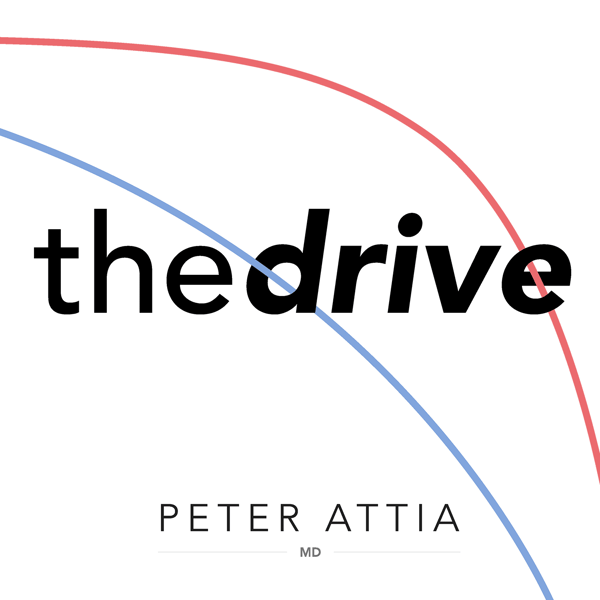#210 - Lp(a) and its impact on heart disease | Benoît Arsenault, Ph.D.
The Peter Attia Drive
Peter Attia, MD
4.7 • 7.3K Ratings
🗓️ 13 June 2022
⏱️ 127 minutes
🧾️ Download transcript
Summary
View the Show Notes Page for This Episode
Become a Member to Receive Exclusive Content
Sign Up to Receive Peter’s Weekly Newsletter
Benoît Arsenault is a research scientist focused on understanding how lifestyle and genetic factors contribute to cardiovascular disease risk. In this episode, the discussion casts a spotlight on Lp(a)—the single most important genetically-inherited trait when it comes to atherosclerotic cardiovascular disease (ASCVD) risk. Benoît explains the biology of Lp(a), how it’s inherited, the importance of measuring Lp(a) levels, and the diseases most associated with high Lp(a). He dives into data on the possible treatments for lowering Lp(a) such niacin, statins, and PCSK9 inhibitors, as well as the most exciting new potential therapeutic—antisense oligonucleotides.
We discuss:
- How Benoît came to study Lp(a)—a new marker for cardiovascular risk [3:15];
- The relationship between Lp(a) and CVD risk [6:45];
- What genome-wide association studies (GWAS) revealed about Lp(a) [16:00];
- Clinical tests to measure Lp(a) [22:00];
- The biology of Lp(a) [25:45];
- How statins lower LDL-cholesterol and why this doesn't work for an Lp(a) [29:15];
- The structure of LDL-p and Lp(a) and what makes Lp(a) more atherogenic than an equivalent LDL particle [34:00];
- The role of Lp(a) in aortic valve disease [42:45];
- How greater numbers of Lp(a) particles are associated with increased risk of disease [48:00];
- The genetics and inheritance of Lp(a) and how and when to measure Lp(a) levels [52:00];
- Niacin and other proposed therapies to lower Lp(a), apoB, and CVD risk [1:00:45];
- Why awareness of Lp(a) among physicians remains low despite the importance of managing risk factors for ASCVD [1:14:00];
- The variability of disease in patients with high Lp(a) [1:19:00];
- Diseases most associated with high Lp(a) [1:26:30];
- The biology of PCSK9 protein, familial hypercholesterolemia, and the case for inhibiting PCSK9 [1:35:00];
- The variability in PCSK9 inhibitors’ ability to lower Lp(a) and why we need more research on individuals with high levels of Lp(a) [1:50:30];
- Peter’s approach to managing patients with high Lp(a), and Benoît’s personal approach to managing his risk [1:54:45];
- Antisense oligonucleotides—a potential new therapeutic for Lp(a) [1:57:15]; and
- More.
Connect With Peter on Twitter, Instagram, Facebook and YouTube
Transcript
Click on a timestamp to play from that location
| 0:00.0 | Hey everyone, welcome to the Drive Podcast. |
| 0:13.0 | I'm your host, Peter Atia. |
| 0:14.8 | This podcast, my website, and my weekly newsletter, all focus on the goal of translating |
| 0:18.7 | the science of longevity into something accessible for everyone. |
| 0:22.4 | Our goal is to provide the best content in health and wellness, full stop, and we've assembled |
| 0:27.0 | a great team of analysts to make this happen. |
| 0:29.4 | If you enjoy this podcast, we've created a membership program that brings you far more |
| 0:33.2 | in-depth content if you want to take your knowledge of this space to the next level. |
| 0:37.3 | At the end of this episode, I'll explain what those benefits are, or if you want to learn |
| 0:41.1 | more now, head over to peteratiamd.com forward slash subscribe. |
| 0:46.3 | Now without further delay, here's today's episode. |
| 0:49.0 | I guess this week is Benoit Arsenal. |
| 0:53.6 | Benoit is an associate professor at the University Institute of Cardiology and Pomenology of Quebec |
| 0:59.9 | at LaValle University. |
| 1:01.7 | He's also a research scientist in the cardiology axis at the Quebec Heart and Lung Institute |
| 1:07.8 | in Canada. |
| 1:09.4 | His research background is in understanding the risk of cardiovascular disease such as |
| 1:13.9 | at the risk of arousis and aortic stenosis in relation to lifestyle and inherited risk |
| 1:18.4 | factors. |
| 1:25.4 | This includes extensive research in the unraveling of the role of L.P. Little A, HDL |
| 1:28.1 | metabolism, PCSK9, and lipid lowering therapies. |
| 1:30.2 | In this episode, we really dedicate our focus to that of L.P. Little A, something that many |
... |
Please login to see the full transcript.
Disclaimer: The podcast and artwork embedded on this page are from Peter Attia, MD, and are the property of its owner and not affiliated with or endorsed by Tapesearch.
Generated transcripts are the property of Peter Attia, MD and are distributed freely under the Fair Use doctrine. Transcripts generated by Tapesearch are not guaranteed to be accurate.
Copyright © Tapesearch 2025.

